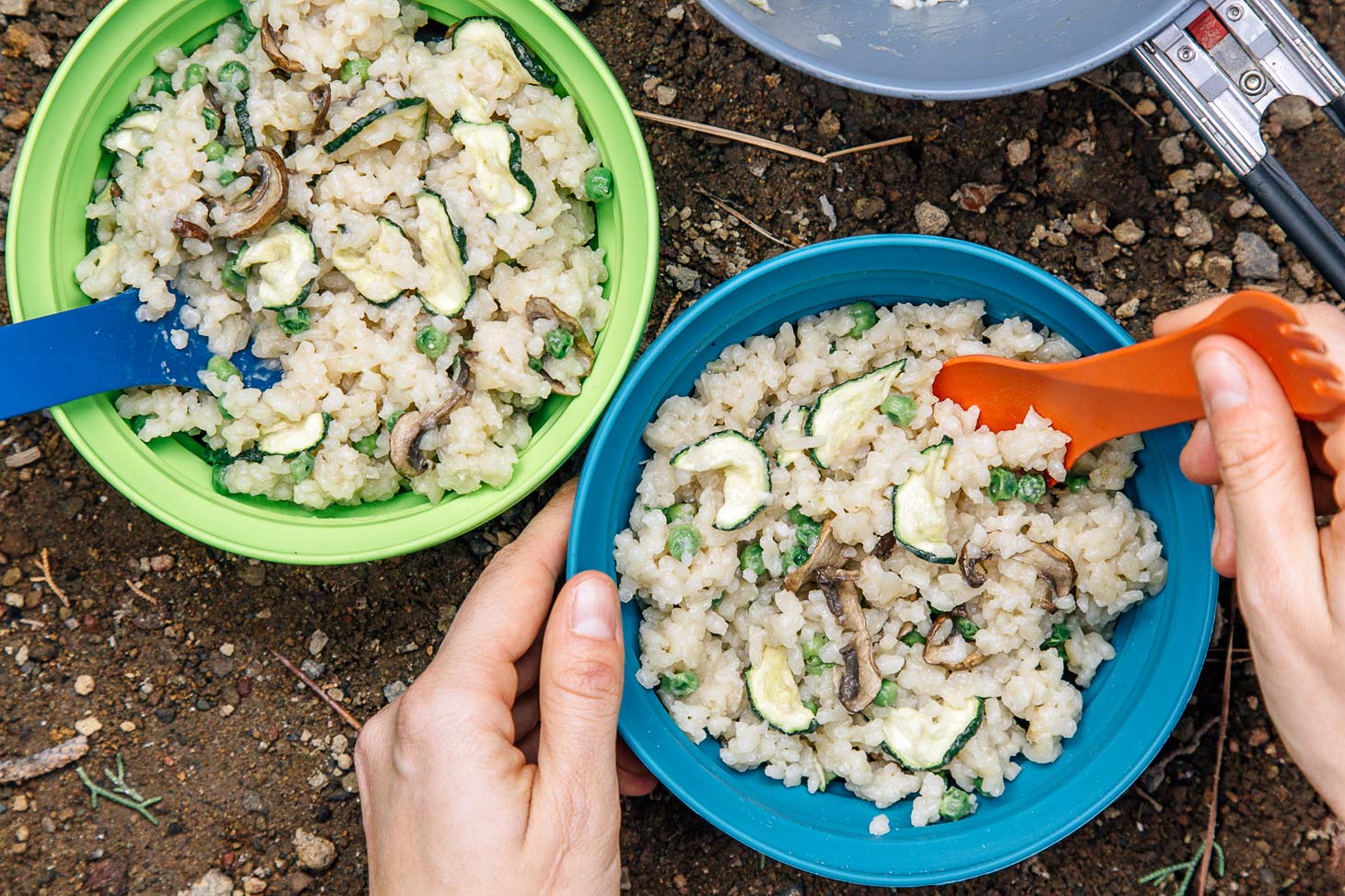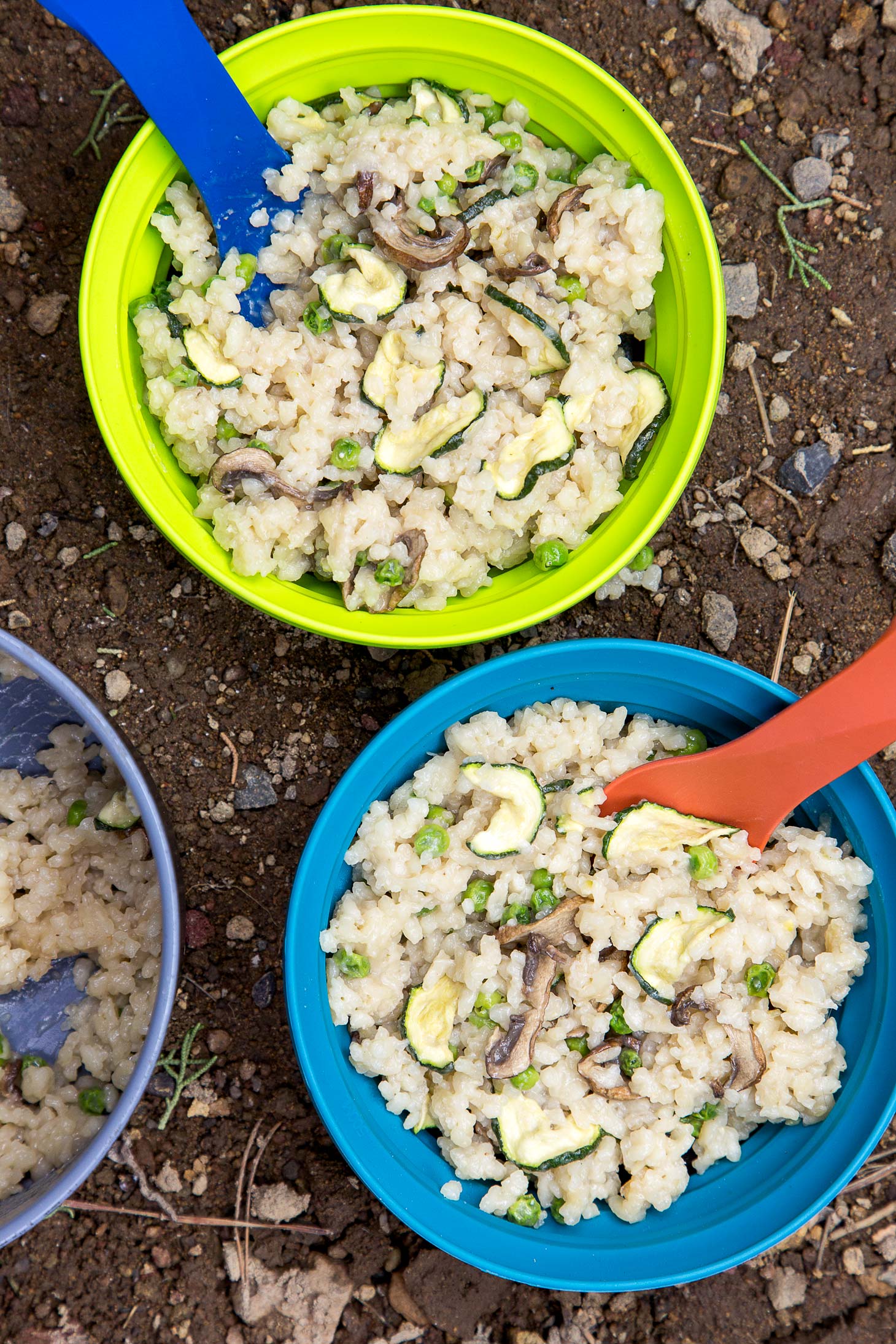Dehydrated Risotto with Vegetables
This backpacking recipe for dehydrated risotto allows you to make delicious homemade risotto quickly and easily in the backcountry without using a lot of fuel.

We love risotto. For us, it’s top of the list in terms of comfort food. On a rainy day or chilly night, nothing brings us joy quite like the smell of a rich and creamy bowl of risotto. It’s hearty and filling, but still surprisingly bright – especially when cooked with white wine and spring veggies!
We can definitely think of a few nights in the backcountry where a bowl of risotto would have been heavenly. (I’m thinking specifically of a cold and stormy we night we rode out in the Mt. Jefferson Wilderness. Yeesh!) But despite its morale-boosting qualities, traditional risotto isn’t all that backpacking friendly.
For starters, it takes a lot of active cooking time. In order to create the starchy creamy broth, risotto needs to be stirred frequently over low controlled heat (something backpacking stoves are notoriously bad at). Long cook times also means burning through a lot of fuel. Not a big deal on overnight trips, but a potential factor on a multi-day hike. Despite all these challenges, we started looking into ways to bring our beloved risotto with us into the backcountry.
The answer is to make the risotto at home and dehydrate it! This way you can perform all the time-consuming parts of the recipe in the comfort of your home kitchen. Then, when you’re out in the field, all you have to do is rehydrate it in some boiling water and it’s ready to eat! No fussy low heat stirring required.
And course, if you’re already dehydrating your risotto at home, then you might as well dehydrate some vegetables to go with it, right? For this particular recipe, we went with zucchini squash, white mushrooms, and peas. (We initially tried asparagus but the fibrous stalks were slow to dehydrate and slow to rehydrate again after.)
After dehydrating for 4-8 hours at 135 F the risotto and accompanying vegetables will be completely dry and brittle. The starch that made the risotto so creamy will have dried out and will coat the outside of each grain of rice. Then just pack all of the dehydrated ingredients together along with some parmesan cheese and bring along a small container of olive oil for added calories.

At the campsite, dump all of the ingredients into a pot, add 2 cups of water, and start to simmer and stir. The rice and vegetables will start to plump back up and all that starchy goodness will return. Rehydrating this meal at camp takes only a fraction of the time it would take to make it from scratch on site.
With a little prep work at home, you too can enjoy the rich creaminess of homemade risotto while backpacking in no time at all!

Tips for Dehydrating Risotto Rice
- Use as little fat when cooking as possible. We usually use a decent amount of butter when making this recipe to eat at home. However, in order to properly dehydrate the rice and prevent it from going rancid, we cut out all of the butter 🙁 and reduced the fat to just 1 tablespoon of oil (you need something to cook the onion and toast the rice with!).
- Spread the rice in as even of a layer on your dehydrator trays as possible. We prefer to use these screen-style trays in our Nesco dehydrator. Since the sauce is so starchy, it doesn’t really drip through the holes, and we find that the rice dehydrates more evenly using these trays. You can use the fruit leather trays as well if that’s all you have and/or your risotto is particularly runny when you go to dehydrate it. If you use the solid fruit leather trays, you may want to flip the risotto when it’s halfway dried to promote even drying.
- Dry at 135F for 4-8 hours. The rice is done when it’s brittle and breaks easily between your fingers.
Risotto with Spring Vegetables
This backpacking recipe for dehydrated risotto allows you to make delicious homemade risotto quickly and easily in the backcountry without using a lot of fuel!
Ingredients
- 1 tablespoon oil
- 1 small onion diced
- 1 cup arborio rice
- 1/2 cup white wine
- 2 cups broth
- Salt
- 1 small zucchini
- 6-8 mushrooms
- ¼ cup frozen peas
- 2 tablespoons parmesan cheese
- 2 tablespoons olive oil packed separately
Instructions
Prepare the risotto: Heat oil in a heavy-bottomed pot. Once shimmering, add the onion and salt and saute 6 minutes. Add the rice and saute 1-2 minutes, until the ends turn translucent. Add the wine and cook, stirring continuously, until it has evaporated. Add the broth and cook, stirring frequently and adding water a half cup at a time as needed when the bottom of the pan is dry, until the rice is tender - about 20 minutes. Remove from heat and let the risotto cool for a bit in the pot.
While the risotto is cooling, cut the zucchini and mushrooms into ¼” slices.
Dehydrate: Places the zucchini, mushrooms, and peas onto your dehydrator trays, taking care to make sure the vegetables don’t overlap. Line an additional dehydrator tray or two (depending on the size) with a mesh or solid tray liner or piece of parchment paper. Spread the risotto onto the tray in an even layer.
Dehydrate 4-8 hours at 135F, until the vegetables and risotto are totally dry. (You may want to check the risotto half way and flip it to ensure even drying.) Store in a sealed, airtight container until ready to cook at camp.
Pack Your Bear Barrel: Pack the risotto, 2 tablespoons cheese, and a small container of olive oil (optional - will add bonus calories to the meal!)
In camp: Place the dehydrated risotto and veggies in a cookpot along with 2 tablespoons parmesan cheese. Add enough water to just cover - about 2 cups. Optional: Let the food soak for a bit to reduce cooking time & fuel consumption. Bring to a boil and then simmer, stirring frequently, until the risotto and vegetables are tender, adding more water if needed. Enjoy!
EQUIPMENT NEEDED - AT HOME
Sharp knife + cutting board
Heavy-bottomed pot or dutch oven
Wooden spoon or spatula
Dehydrator + tray liners
Sealable container/baggie
EQUIPMENT NEEDED - AT CAMP
Backpacking stove
Cookpot
Spoon
Bowls for serving (optional)

Source: https://www.freshoffthegrid.com/dehydrated-risotto-vegetables/